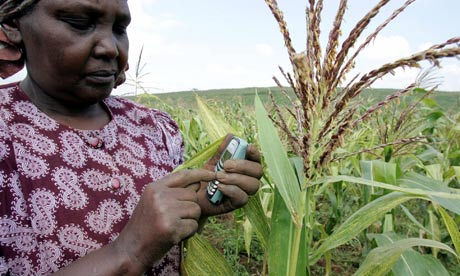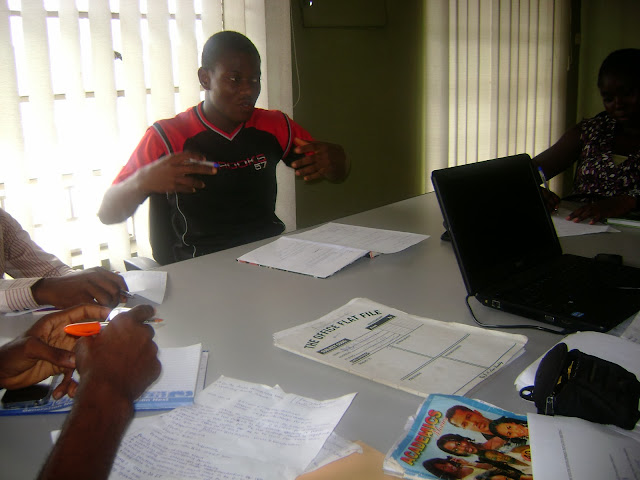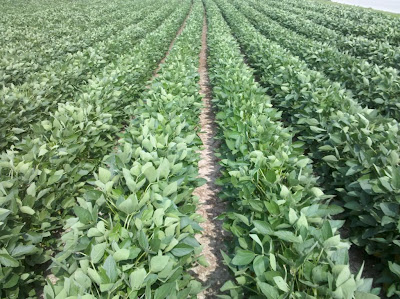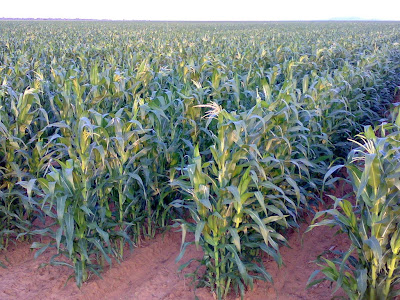This Chapter presents the findings on the impact of HIV/AIDS
on agricultural production. The impact of HIV/AIDS is analysed on the
basis of
the 3 categories (i) crop farming, (ii) livestock farming, and (iii)
fishing.
Most studies, which have been carried out on the impact of HIV/AIDS on
the
economy in general, have tended to focus on crop farming with less
attention on
livestock farming. In this study attempts were made to analyse the
impact of
HIV/AIDS on livestock farming.
The socio-economic dynamics in fishing communities unlike in
crop and livestock farming communities make them more susceptible to HIV
infection, and the impact of the epidemic. The impact of HIV/AIDS on
fishing
can, first and foremost, be appreciated by examining the basic
characteristics
of household members involved in fishing in the lake.
4.1. Impact of HIV/AIDS on crop
farming
The impact of HIV/AIDS on the agricultural sector is
quite
visible in districts that have been hard hit by the epidemic. This has
far
reaching implications since agriculture accounts for 43% of GDP, 85% of
export
earning and 80% of employment. In addition, 85% of the estimated 22
million
Uganda's total population live in rural areas and depend mainly on
agriculture
(GoU, 2000). Since most agricultural activities take place in rural
areas, where
farmers mainly using labour intensive techniques live, and have been
much
vulnerable to HIV/AIDS, it has resulted into decline of agricultural
production
in general, and food production in particular. Many communities whose
source of
income, food and general livelihood is agriculture have registered
negative
growth due to HIV/AIDS. In this study, empirical data on the impact of
HIV/AIDS
on agricultural production is analyzed.
Type of crops
In all the 4 districts,
farmers were small landholders,
majority owning less than 8 acres of land, and using labour intensive
techniques
in their cultivation; a hoe, pang and axe. Most of the households were
growing
crops on small portions of land, while big portions of land were not
cultivated.
Most of the crops both for food and sale were labour intensive crops,
most
susceptible to HIV/AIDS.
Tubers such as cassava, yams, sweet potatoes etc, which seem
not to be much labour intensive such as bananas (
matooke) were
the
dominant food crops in all districts except Mbarara. Legumes such as
beans,
groundnuts, peas were the second dominant crops followed by cereals. In
areas of
Mbarara and Rakai, which are
matooke growing areas, it is
becoming
evident that HIV/AIDS has had its toll as only less than a half of the
households in respective areas reported
matooke as their dominant
food
crop.
In the four districts, there were no marked cash crops. The
food crops doubled as crops for sale, but also among few households.
Most
households, which, sold off crops mainly cereals (rice, millet, and
maize), were
in Lira and Iganga. In the districts of Mbarara and Rakai very few
households
had crops to sell.
As a proxy indicator of the impact of HIV/AIDS, respondents
were asked whether there were certain crops, which they used to grow,
but were
no longer growing in the last 10 years preceding this study. Several
households
(64.8%) indicated that there were certain crops, which they used to grow
in the
past, but were no longer growing. Most of these households (i.e., over a
tenth,
12.8% had stopped growing cereals such as millet, sorghum, maize etc.
The
dominant reason for not growing such crops was cited to be lack of
labour in
almost a fifth of the sampled households (19.2%). In a few households it
was as
due to pests and diseases as a result of poor management, infertile
soils and
lack of market.
In a situation where there are small landholders, it would be
expected that much if not all the land would be under cultivation in
crop
growing communities. However, the study findings revealed that a big
proportion
of the households (60.1%) had unused land or gardens that had reverted
into bush
due to lack of manpower. When this was cross tabulated by districts,
majority of
such households were in Lira (82%) and Rakai (64%) districts.
Social maps drawn by community members in Lira indicated a
number of households than had been affected by HIV/AIDS related deaths,
with
gardens that had reverted to bush. Households with unused land that was
formerly
under cultivation attributed it to lack of labour, lack of money to hire
labour
and conversion of cultivable land into grazing pastures etc.
Trend/pattern of agricultural
production
Household respondents were requested to comment on the
household's agricultural production in the last 10 years so as to link
with
possible effects of HIV/AIDS. Majority of the household respondents
(76.9%)
revealed that their respective households had experienced decreased
agricultural
production in the last 10 years.
A number of factors, all related with HIV/AIDS explain the
general pattern/trend of decreased agricultural production such as
depletion of
labour force and increased workload due to increased dependency burden,
loss of
skills and knowledge, and income disruption.
Several studied households (66.9%) mentioned shortages of
labour to be behind decreased agricultural production in their
households. In
almost a fifth of the sampled households, labour shortages were directly
linked
to HIV/AIDS related deaths.
Accordingly, AIDS undermines agricultural systems, affects the
nutritional situation and food security of rural families. Families face
declining productivity as well as loss of knowledge about indigenous
farming
methods and loss of assets (Focus, 2001). FAO estimates that in the 25
most-affected African countries, AIDS has killed seven million
agricultural
workers since 1985. It is forecasted that 16 million people will die of
AIDS in
the next 20 years. Labour intensive farming systems with a low level of
mechanisation and agricultural input are particularly vulnerable to
AIDS. Given
the fact that AIDS is concentrated among the 15 - 45 years old, who are
most
able bodied, then agriculture suffers most in terms of production and
market for
the accruing products.
For women who are the main producers generally shoulder the
burden of caring for the sick. This diverts their energies from
agricultural
production and general work that would provide income. The result is
household
food insecurity, declining nutrition and health. Thus, the decline in
women's
contributions to agriculture, as a result of their own illness or that
of family
members, reduces agricultural productivity and household food security.
This is
especially devastating given women's key role in the agricultural work
force and
in the production of most subsistence food crops.
Labour loss and depletion as a result of HIV/AIDS partly
occurs due to high dependency burden, coupled with structural changes in
family
structure. Situations where frail grandparents are increasingly assuming
roles
of able-bodied persons to care for the children of their late sons and
daughters
are common. In such households, food production declines, and the family
becomes
perpetually food insecure. A household case in Ngara area, Nyakayejo
illustrates
the point.
Case 1: Food Insecurity in a Grandfather Headed
Household
Paulo, a widower aged 80 years old lives in Ngara
village, Nyakayejo Sub-county in Mbarara district with 5 grandchildren
who are
orphans aged 5,7,8, years who were left behind by his daughter and a son
who
died of AIDS. Paulo narrates, "I used to be self-reliant, hardworking,
supplemented my little income from farming with carpentry work, but when
my
children died, leaving behind children and nobody else to take them up
except
me, my life changed. I am not only a grandfather to these children, but a
father
and a mother at this advanced age.... I am now sick and cannot afford to
dig or
to do carpentry work any more after an operation I underwent, coupled
with old
age. It puts me in great pain, for I don't know what will happen to
these
children once I die as they all depend on me".
The old man
has a
banana plantation, but the biggest part is overgrown with weed due to
lack of
enough manpower. Together with the orphans, they cannot carry out
meaningful
cultivation even though the orphans are not attending school. There has
been
sharp reduction in food for consumption available for the family as the
old man
continued narrating, "even now when I am still alive, we do not have
enough to
eat...you can see that young one (pointing to the youngest orphan) is
gloomy not
because he is sick or has been punished, but because he has not eaten
anything
since morning". As a coping mechanism, the household feeds on one meal
(supper)
a day, and take some local porridge for lunch. |
The above case illustrates how HIV/AIDS has changed the family
structure, with frail grandparents assuming responsibilities of "fathers
and
mothers", but yet cannot meaningfully execute such roles of fending for
the
family. The case also points to occurrences of food insecurity among
HIV/AIDS
affected households and psychological trauma. When the grandparent is
preoccupied with "what will happen" to his grandchildren after his
death, it
points to, among others, the need for psychosocial support, and
deliberate
programmes to help such families.
The relationship between change of family structure as a
result of HIV/AIDS and reduction in agricultural production is more
evident in
this study as all households headed by grandparents or children
themselves,
reported decreased agricultural production.
Declined agricultural production and consequently food
insecurity were markedly prevalent in grandparent and child headed
households
than in other households. A case of a grandmother headed household
illustrates
the trend of agricultural production in such households.
Case 2: Declined agricultural production and food
insecurity in a grandmother headed household
Agellina, a
widow and
grandmother aged 65 years old lives in Kakuto Parish, Kigayaga village,
Rakai
district. In a small mud and wattle iron roofed house, lives 10 people
(4 males
and 6 females), 8 of whom aged below 14 years old. All the nine other
members of
the household are her grandchildren who were orphaned by AIDS. Agellina
had
produced 4 children, three of whom died of HIV/AIDS related illnesses in
1990s
together with their spouses, leaving behind 9. Six of her grandchildren
including the eldest who is 14 years old have dropped out of school
partly due
to lack of other school necessities (i.e., save for tuition, which is
covered
under Universal Primary Education), and to supplement the grandmother's
failing
input on the small banana plantation.
The family
depends
on a small plantation for it food requirements and beans grown in the
banana
plantation. The family has some land of 2.5 acres reserved for
cultivation, but
can only cultivate less than an acre. According to Angellina "the family
does
not have labour to tend to both the plantation and the garden of beans",
and
hence have been exposed to weevil and pest infestation.
The family has witnessed declined food production and
consumption as
well. The children playing in the courtyard looked hungry and
malnourished. The
grandmother in touching emotions observed, "we only have one meal a day,
and
also not adequate...we let the small ones first eat...a type of life
that they
were not used to".
Angellina is planning to sell part of
2.5 acres
of land so as to raise some income for meeting the basic necessities
including
food for the family. |
The above case shows how changes have occurred in family
structure due to HIV/AIDS and the attendant consequences of decreased
agricultural production. This finding is supported by findings from
secondary
sources. For instance, according to UAC (March 2001), Uganda has the
highest
proportion of AIDS orphans in the whole world. By the end of 1999 UAC
estimated
that over 1.7 million children below 15 years had lost one or both
parents to
AIDS.
However, a dimension in the above case that did not feature in
the case of Paulo in Mbarara is weevil/disease infestation due to poor
management of gardens. Some of these diseases were as a result of poorly
or
unattended gardens/banana plantations due to labour depletion resulting
from of
HIV/AIDS. Some of the diseases and pests included banana steak virus
mainly in
Kyotera county, coffee wilt, beans bacterial, fungal and viral, sweet
potato
caterpillars and cassava green mites etc. Cassava mosaic which used to
be a
problem in most areas was reported to be on the decrease due to the
introduction
of new resistant/tolerant varieties from the National Agricultural
Research
Organization (NARO). Also in the above case, a new dimension of selling
the
family property such as land in order to cope with the new demands
arising from
HIV/AIDS emerges.
A lot of literature points to similar situations in several
parts of the country that have been hard hit by HIV/AIDS. For instance,
FAO
(2001) summarised the impact of AIDS on a once wealthy rural
agricultural
community of Gwanda in Rakai district. HIV/AIDS was reported to have
resulted
into loss of labour, poor land use, increased pests and plant diseases,
livestock decline and food insecurity. All these put together have
resulted into
massive poverty, and undermining of sustainable development. Apart from
reduction in incomes accruing from the agricultural sector, decline in
food
production which, culminates into food insecurity has adverse impact on
PLHA in
particular. Decline in production of local foods implies that the
nutritional
requirements for PLHA are not met, which affects their life span.
Further, the affected and afflicted family, and the wider
community feel the impact of HIV/AIDS through reduced agricultural
production.
Culturally, when death occurs in most parts of Uganda, community members
take
off time for burial and in some instance observing the mourning period
i.e., not
attending to their gardens. Eeven in majority households where a member
had not
died in the last 10 years, reported decreased food production.
Both quantitative and qualitative data revealed that as a
result of HIV/AIDS, crop-farming households were faced with the
following:
- Loss of
time
- Labour shortages
- Selling household
property
- Loss of knowledge and
skills
- Exhaustion of funds
- Land and
property
grabbing
- Increased dependants
























































